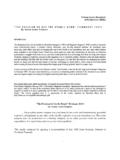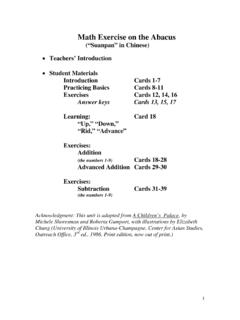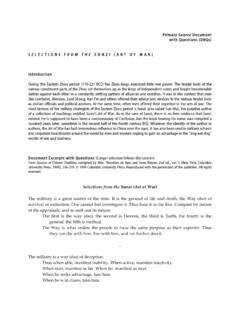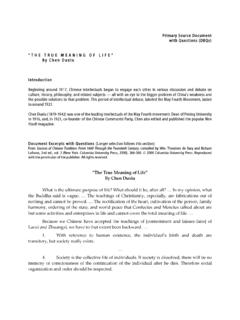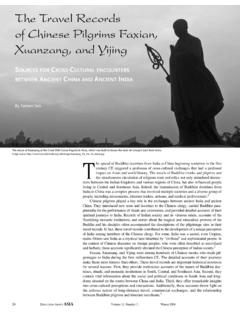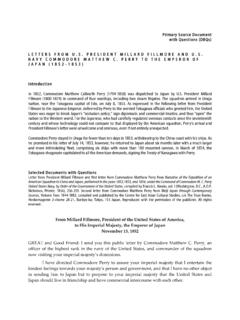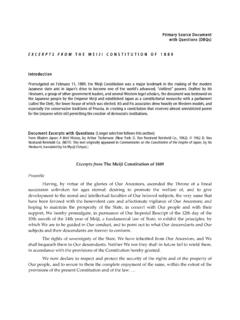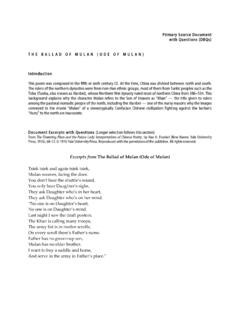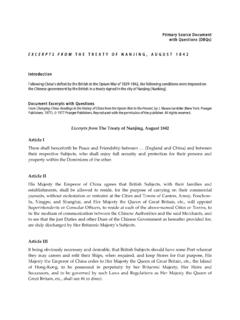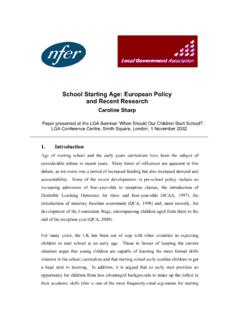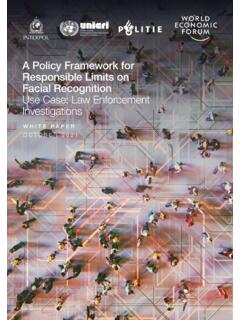Transcription of The Mongols in World History - Columbia University
1 Asian Topics in World History | Columbia University The Mongols in World History * This is a transcript of the text found at < >. For working links to images, PDF documents, and readings cited throughout this transcript, please visit the website. * The Mongols Mark on Global History a new look at Mongol contributions The Mongol Conquests what led to the conquests, and why were they so successful? The Mongols in China the Mongols influence on China s Yuan dynasty Key Figures in Mongol History a closer look at four important figures The Pastoral-Nomadic Life key elements in the Mongols pastoral-nomadic way of life THE Mongols MARK ON GLOBAL History The Barbarian Stereotype Most Westerners accept the stereotype of the 13th-century Mongols as barbaric plunderers intent merely to maim, slaughter, and destroy. This perception, based on Persian, Chinese, Russian, and other accounts of the speed and ruthlessness with which the Mongols carved out the largest contiguous land empire in World History , has shaped both Asian and Western images of the Mongols and of their earliest leader, Chinggis Khan.
2 Such a view has diverted attention from the considerable contributions the Mongols made to 13th- and 14th-century civilization. Though the brutality of the Mongols military campaigns ought not to be downplayed or ignored, neither should their influence on Eurasian culture be overlooked. A New Look at Mongol Contributions The Mongol era in China is remembered chiefly for the rule of Khubilai Khan, grandson of Chinggis Khan. Khubilai patronized painting and the theater, which experienced a golden age during the Yuan dynasty, over which the Mongols ruled [also see The Mongols in China: Cultural Life Asian Topics in World History | Columbia University The Mongols in World History | This is a transcript of the text found at < >. For working links to images, PDF documents, and readings cited throughout this text, please visit the website. under Mongol Rule, below]. Khubilai and his successors also recruited and employed Confucian scholars and Tibetan Buddhist monks as advisers, a policy that led to many innovative ideas and the construction of new temples and monasteries.
3 The Mongol Khans also funded advances in medicine and astronomy throughout their domains. And their construction projects extension of the Grand Canal in the direction of Beijing, the building of a capital city in Daidu (present-day Beijing) and of summer palaces in Shangdu ( Xanadu ) and Takht-i-Sulaiman, and the construction of a sizable network of roads and postal stations throughout their lands promoted developments in science and engineering [also see The Mongols in China: Civilian Life under Mongol Rule, below]. Perhaps most importantly, the Mongol empire inextricably linked Europe and Asia and ushered in an era of frequent and extended contacts between East and West. And once the Mongols had achieved relative stability and order in their newly acquired domains, they neither discouraged nor impeded relations with foreigners. Though they never abandoned their claims of universal rule, they were hospitable to foreign travelers, even those whose monarchs had not submitted to them.
4 The Mongols also expedited and encouraged travel in the sizable section of Asia that was under their rule, permitting European merchants, craftsmen, and envoys to journey as far as China for the first time. Asian goods reached Europe along the caravan trails (earlier known as the Silk Roads ), and the ensuing European demand for these products eventually inspired the search for a sea route to Asia. Thus, it could be said that the Mongol invasions indirectly led to Europe s Age of Exploration in the 15th century. Support for Foreign Contact and Exchange The Mongols receptiveness to foreigners was a critical factor in promoting cultural exchange and a truly global History . Their attitude of relative openness toward foreigners and foreign influence led to an extraordinary interchange of products, peoples, technology, and science throughout the Mongol domains.
5 So it is no accident that Marco Polo reached China during this era [also see Key Figures in Mongol History : Marco Polo, below]. And also no accident that Ibn Battuta, the great Islamic traveler from Morocco, also reached China during this time, and that Rabban Sauma, a Nestorian Christian from the area around Beijing, reached Europe and had audiences with the kings of England and France and the Pope. From the Mongol period on, then, we can speak about a Eurasian if not a global History , in which developments in one part of Europe would have an impact not only in Europe but also in Asia, with the same being true for Asia. And if we remember that Christopher Columbus was actually looking for a new route to Asia when he landed in America and that one of the few books he had with him was Marco Polo s account of his travels in Asia we could even say that global History begins with the Mongols and the bridge they built between the East and the West.
6 P. 2 of 29 Asian Topics in World History | Columbia University The Mongols in World History | This is a transcript of the text found at < >. For working links to images, PDF documents, and readings cited throughout this text, please visit the website. Missionaries from Rome: Bridging East and West The Mongol Era brought about the first instances of direct contact between Europe and Mongol-ruled China. The Mongol attacks on Hungary and Poland in 1241 had alerted the Europeans to the power of the Mongols and so frightened them that, in 1245, the Pope in Rome called an Ecumenical Council to deliberate on a response to the Mongols . Two Franciscan missionaries were eventually dispatched to the East. The first, who left Europe in 1245, was John of Plano Carpini, and the second was William of Rubruck, who traveled through the Mongol domains during 1253-1255. Both sought to achieve a kind of rapprochement with the Mongols , attempting to deter them from further attacks and invasions on Europe, as well as seeking to convert them to Christianity.
7 The Europeans had received information that the Mongols had a leader, named Prester John, who had converted to Christianity. They also assumed that many of the Mongols already were Christians. In fact, some Mongol women, including Chinggis Khan s own mother, had converted to a heretical form of Christianity known as Nestorian Christianity. The Nestorian sect had been banned from Europe from around the 5th Century , but had first spread to West Asia and then reached all the way to East Asia. But the idea that the Mongols could be converted to Christianity was an illusion at best. Nonetheless, John of Plano Carpini and William of Rubruck were greeted cordially at the Mongol courts. Though they succeeded in neither their religious nor diplomatic missions, they were able to bring back the first accurate accounts of the Mongols . Mongols Support trade , Facilitating East-West Contacts Along with Western missionaries, traders from the West (particularly from Genoa) began to arrive in the Mongol domains, mostly in Persia and eventually farther east.
8 The Mongols were quite receptive to this. This attitude, which facilitated contacts with West Asia and Europe, contributed to the beginning of what we could call a global History , or at least a Eurasian History . The Mongols always favored trade . Their nomadic way of life caused them to recognize the importance of trade from the very earliest times and, unlike the Chinese, they had a positive attitude toward merchants and commerce. The Confucian Chinese professed to be disdainful of trade and merchants, whom they perceived to be a parasitical group that did not produce anything and were involved only in the p. 3 of 29 Asian Topics in World History | Columbia University The Mongols in World History | This is a transcript of the text found at < >. For working links to images, PDF documents, and readings cited throughout this text, please visit the website. exchange of goods. Mongols altered that attitude and in fact sought to facilitate international trade [also see The Mongols in China: Life for Merchants under Mongol Rule, below].
9 In China, for example, the Mongols increased the amount of paper money in circulation and guaranteed the value of that paper money in precious metals. They also built many roads though this was only partly to promote trade these roads were mainly used to facilitate the Mongols rule over China. The Status of Merchants Improved under Mongol Rule Under Mongol rule, merchants had a higher status than they had in traditional China. During their travels they could rest and secure supplies through a postal-station system that the Mongols had established. The postal-station system was, of course, originally devised to facilitate the transmission of official mail from one part of the empire to another. Set up approximately every 20 miles along the major trade routes and stocked with supplies of food, horses, and lodging, the stations were an incredible boon to all travelers, whether they were traveling for business or otherwise.
10 Under the Mongols , merchants also had the benefit of not being faced with confiscatory taxation, as was the case during the rule of the traditional Chinese dynasties. Support for trade characterized not only mongol policy in China but their policy throughout their domains. In Persia the Mongols granted higher tax breaks and benefits to traders in an effort to promote commerce. The Mongols even tried to introduce paper money into Persia though this would become merely a failed experiment. Nonetheless, the attempt indicates the desire of the Mongols to provide additional assistance to traders. Merchants Associations Alleviate the Perils of Caravan trade To further support trade and commerce, the Mongols established merchant associations, known as Ortogh, specifically to promote caravan trade over long distances. The Mongols recognized that the caravan trade across Eurasia was extraordinarily expensive for any single merchant.
